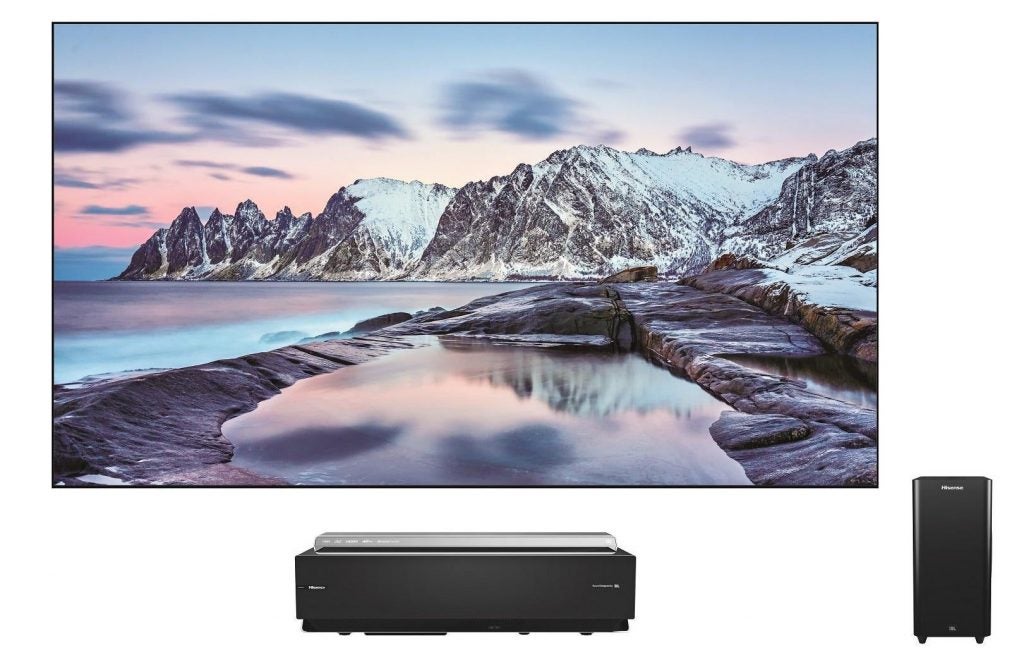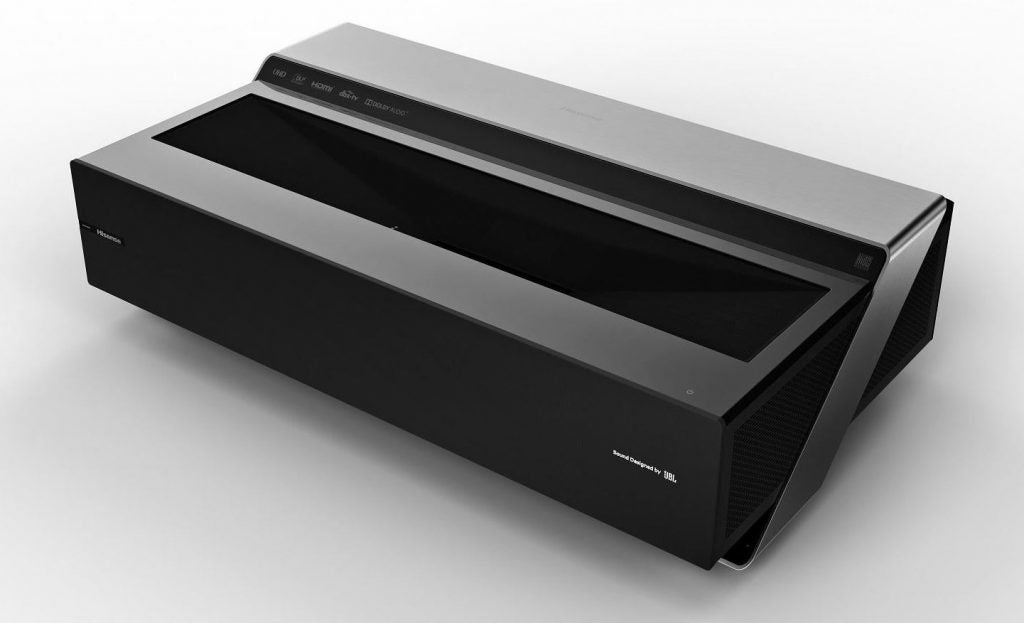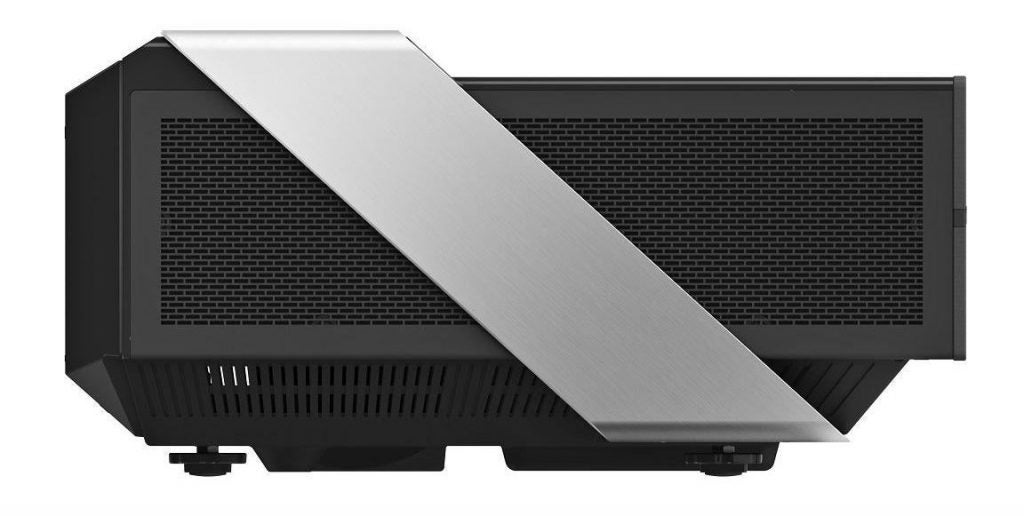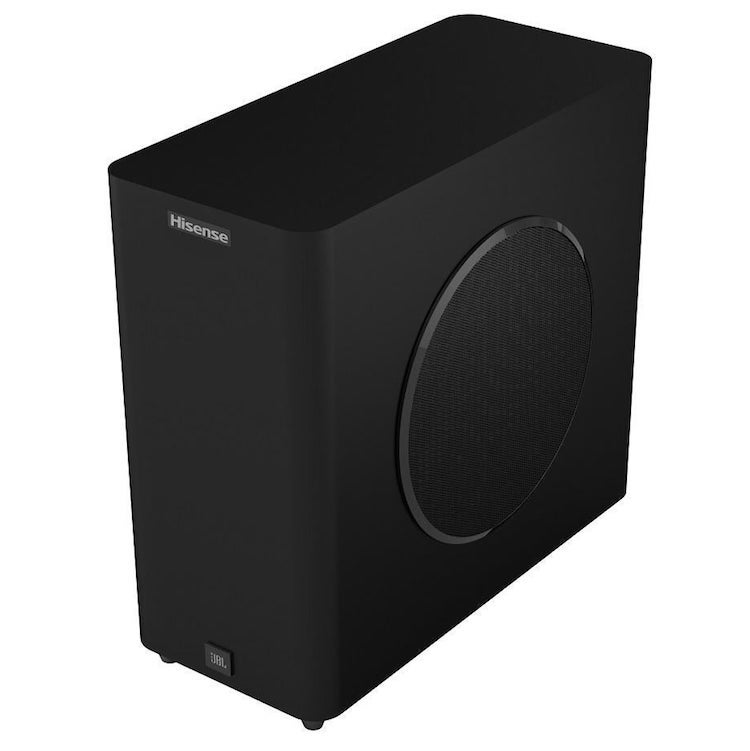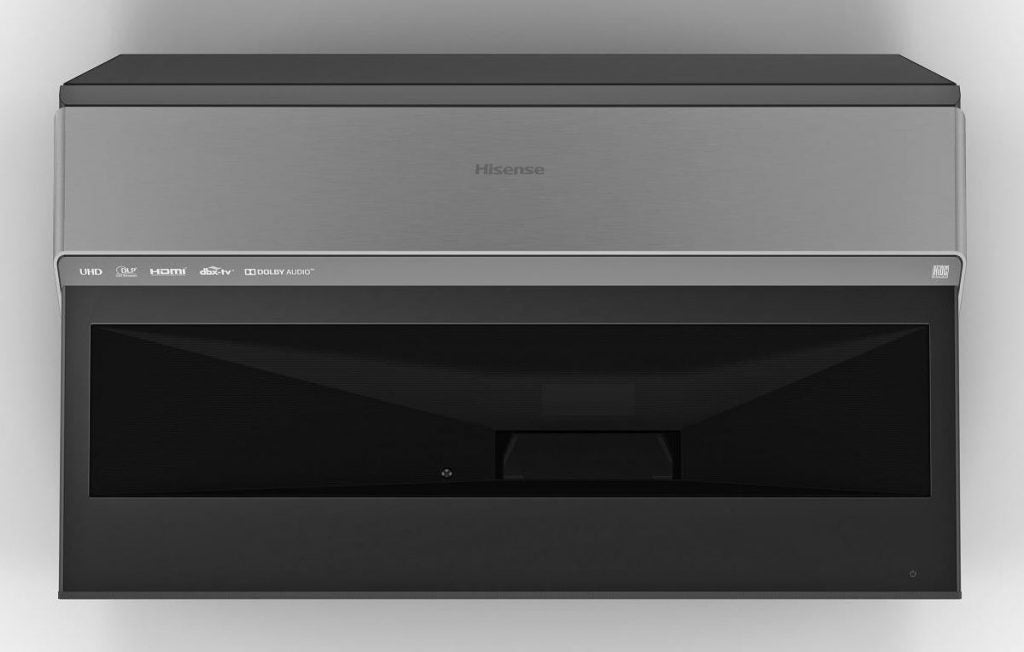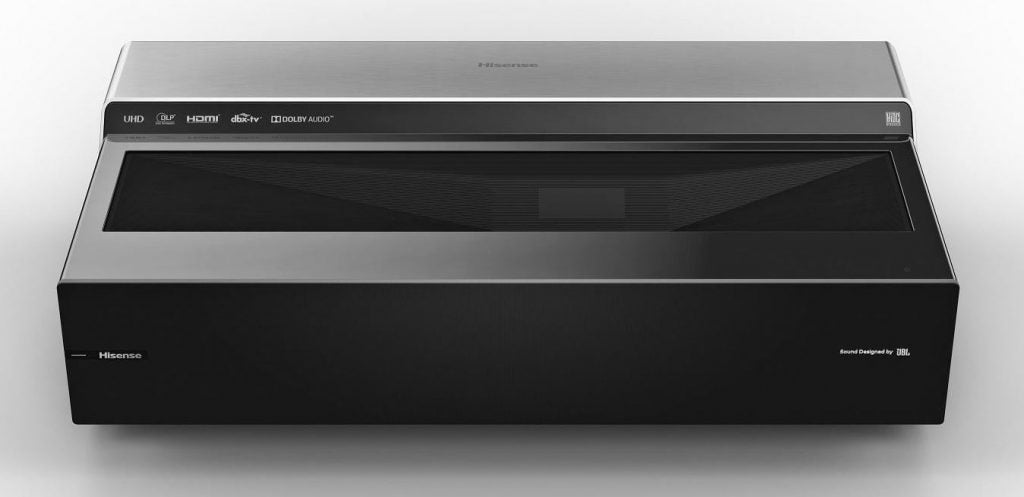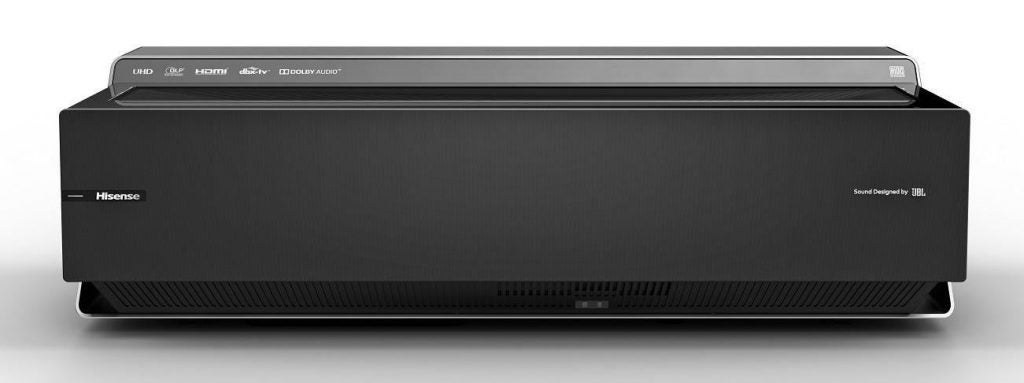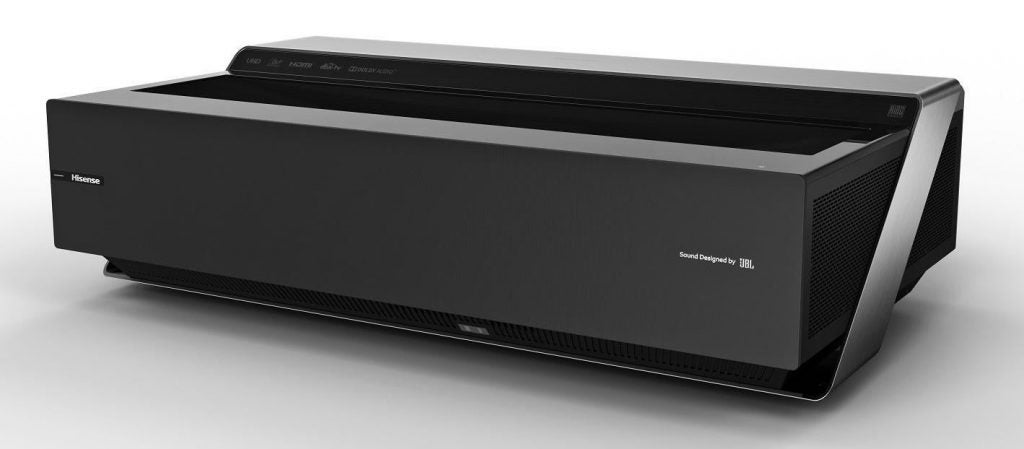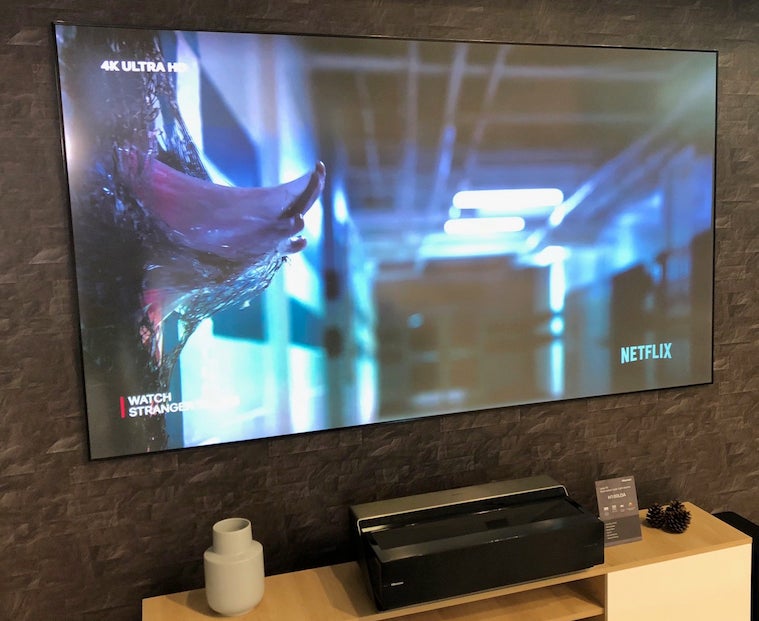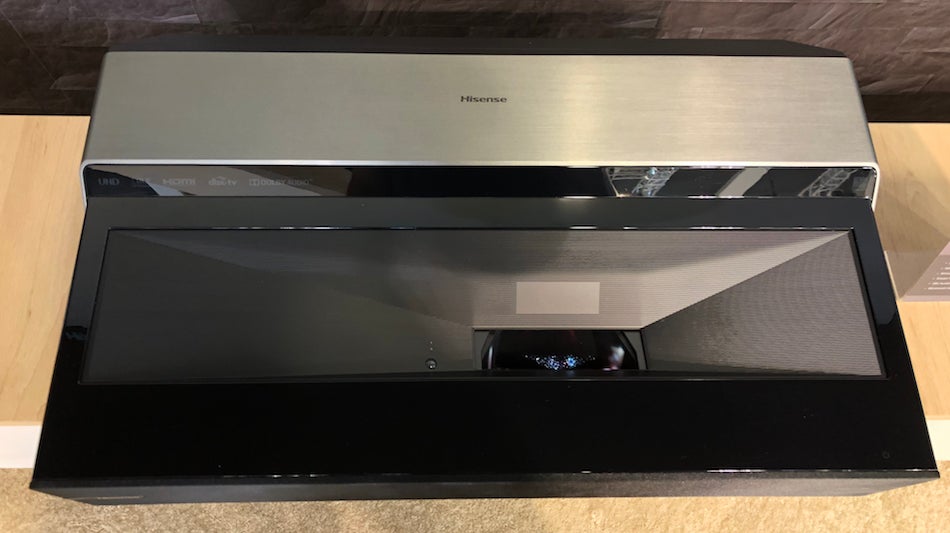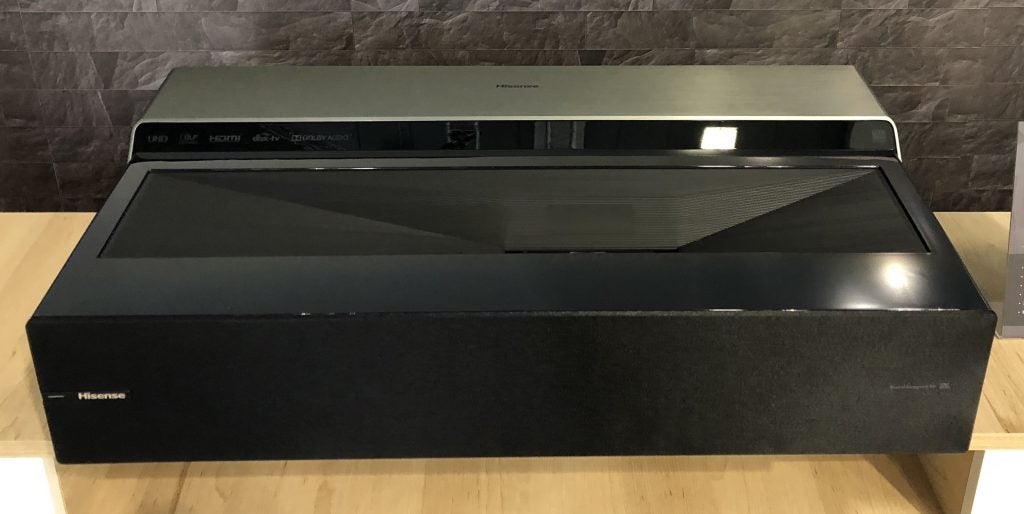Hisense H100LDA Review
Hisense H100LDA Review
Hisense's "Laser TV" delivers a projector and screen in one
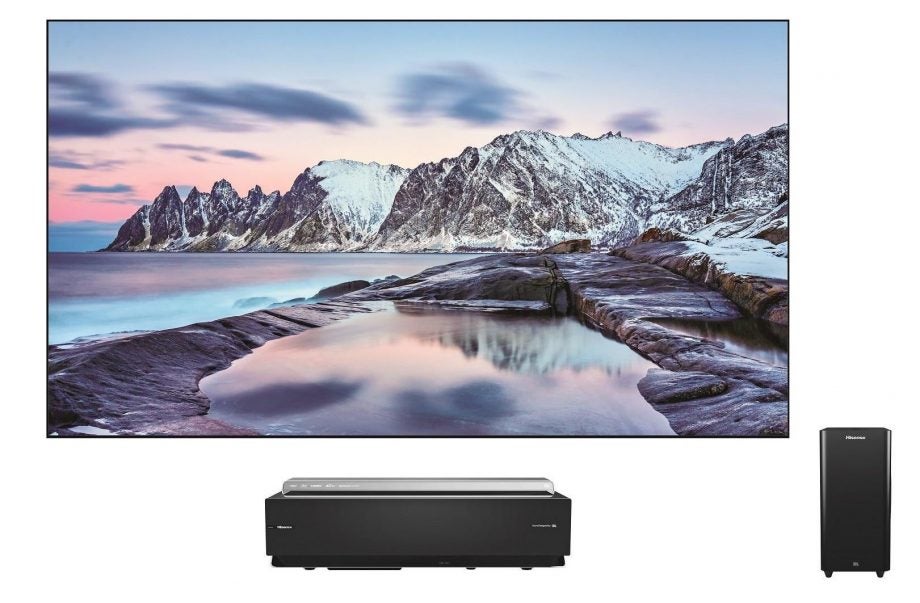
Verdict
Provided you understand what it is and can live with its performance foibles (especially the likely reflections on your ceiling and walls), the Hisense H100LDA is an unexpectedly effective and, all things considered, not insanely expensive way of getting truly huge TV pictures in your living room.
Pros
- Remarkably bright, colourful pictures even in light rooms
- Good sound
- Fair value for what it offers
Cons
- Rainbow effect
- Casts off strong reflections onto walls and ceiling
- Limited viewing angle
Key Specifications
- Review Price: £10999
- 100in ultra-reflective screen
- 3000-nits ultra short-throw laser projector
- Built-in 80W sound system, designed with JBL
- Built-in VIDAA smart system
- 4K resolution
The £10,999 Hisense H100LDA is a truly unique proposition for the UK TV market. It’s an ultra short-throw 4K laser projector partnered with a rigid, high-gain 100in screen with built-in sound system, complete with external subwoofer.
In other words, it’s designed to give you the sort of screen size associated with home cinema, without the need for a perpetually dark environment – or to have a projector stuck slap bang in the middle of your living room. No wonder, then, that Hisense likes to call the H100LDA a Laser TV.
Related: Best TVs
Hisense H100LDA design – Not just a pretty face
The screen and projector elements of the Hisense H100LDA are both reasonably pretty given that they’re really more about function than form.
The rigid screen features an appealingly slim black bezel, offset around its outside edges by a cute silver metallic trim.
The projector part is pretty chunky – as it kind of has to be given the need to fit in an ultra short-throw lens array, sufficient fans and ventilation space to stop its powerful laser light engine melting stuff, and a stereo speaker system. But there’s actually something quite cool about it all the same.
Even the subwoofer looks appealing thanks to its smooth finish and rounded corners.
All three physical elements of the Hisense H100LDA appear to be built to a high standard. The screen’s rigid form should ensure uniformity from one corner to the other (provided the wall you put it on is totally flat!), and the projector is heavy and solid.
The Hisense H100LDA ships with an attractive and thoughtful remote control that sensibly keeps the button count low. It places what buttons there are into a nicely spacious layout that’s easy to find your way round. What’s more, as a reminder that Hisense is pitching the H100LDA as a TV rather than a projector, the remote carries a dedicated Netflix button.
Hisense H100LDA features – Projector and screen combine for all-in-one functionality
The combination of a very bright laser projector and a rigid, reflection-suppressing high-gain screen add up to the Hisense H100LDA’s USP: huge 100in pictures you can watch in a normal living room without the expense associated with buying a similarly massive LCD TV.
The projector continues the “it’s a TV, not a projector” illusion by carrying a Freeview HD tuner, as well as the sort of connections you’d normally find on a television. These include four HDMIs, two built to the HDMI 2.0 specification, and two built to the older 1.4 configuration.
One of the two 2.0 HDMIs carries audio return channel (ARC) support, too, but not the new eARC system that would enable it to pass lossless Dolby Atmos and DTS-X through to soundbars or AV receivers.
The projector’s built-in audio system (designed in conjunction with acclaimed audio brand JBL) decodes Dolby Digital Plus, but has “only” a 2x10W plus external 60W subwoofer speaker system to play it through. There’s no option for adding further external speakers.
There are also two USBs for multimedia playback, an optical digital audio output, Bluetooth support, a D-SUB PC port (reflecting the fact that a product like this could also work well in business presentation rooms) and both LAN and Wi-Fi network options.
Related: Best projectors
There’s no headphone jack, and it’s a pity neither of the USBs is placed on the projector’s front for easier access. Otherwise, you’re talking about a level of connectivity that goes far beyond anything you’d get with a typical projector.
The laser at the Hisense H100LDA’s heart is powerful, pumping out a claimed 3000 lumens of maximum brightness and contributing to a power throughput of 440W. So powerful and focused is the light from the laser, in fact, that the projector cuts off the picture automatically if it senses the presence of a face or body anywhere near it in order to protect your eyes.
The Hisense H100LDA is a 4K projector, and feeds its laser light into a single-chip DLP projection engine that achieves its 4K claims via Texas Instruments’ “double flashing” technology (rather than being truly natively 4K like Sony’s 4K projectors).
It supports HDR in the HDR10 and HLG flavours; there’s no support for HDR10+ or Dolby Vision. This is the case with all home projectors I know of.
However, the H100LDA does differ from normal projectors by carrying a fully developed smart TV system. In fact, it gets the same VIDAA platform found on many of Hisense’s TVs, complete with a an attractive, icon-driven graphical interface and an impressively fulsome set of apps.
These include Netflix, Amazon Prime Video, YouTube, Rakuten TV, Chili Cinema, and all of the main UK terrestrial catch-up services. There’s even support for Freeview Play, which brings all those UK catch-up platforms under one, easy to browse umbrella interface.
The Netflix, Amazon and YouTube apps all play back content in 4K and HDR where available – although, obviously, there’s no support for Netflix or Amazon’s Dolby Vision or HDR10+ streams.
There’s no support for Google Play or Now TV, but getting the level of app support the H100LDA provides is still a revelation for a video system built around a projector.
The screen part of the H100LDA package uses a multi-layered panel structure to focus the light received from the projector back towards the viewer. It does this while simultaneously (via a circular Fresnel structure on its surface) reflecting ambient light away from your line of vision.
The Hisense H100LDA provides four HDR picture presets (HDR Night, HDR Day, Dynamic and HDR Game), and five standard dynamic range presets (Standard, Cinema Day, Cinema Night, PC/Game and Dynamic). I’ll cover these in more detail in the Setup section of the review.
There are also two noise reduction systems, various motion processing settings, and full calibration tools for colour, gamma and white balance (with 2pt or 10pt calibration).
Related: What is HDR?
One last great feature is Hisense’s commitment to a “white glove” installation service for every H100LDA it sells. This is handy given the tough combination of technical and precision installation challenges you’d face if you were trying to set up a H100LDA yourself.
After all, don’t forget that with a short-throw projector system such as this, even the slightest misalignment between the screen and the projector would result in focus and brightness uniformity issues.
Hisense H100LDA setup – Plenty of HDR options at your disposal
The H100LDA’s various picture presets have a dramatic impact on how its pictures look. As such, there’s more to cover in this section than usual.
Looking first at the four HDR presets, they all do interesting things. HDR Dynamic opens up the HDR image, delivering a more expansive HDR experience. It uses a lower baseline brightness level but provides deeper black levels and more distinct brightness highlights. In some ways, it does precisely the opposite to what I’d expect a “Dynamic” mode to do – namely, just crank everything up to 11.
The Dynamic preset is the one to go for in a relatively dark environment. In fact, for reasons I’ll cover in the next paragraph, it might become serious AV fans’ go-to preset for all viewing, no matter the room conditions.
HDR Day and Night both go for a much higher brightness baseline and much more heavily saturated colours, making them remarkably good at “punching through” ambient light. Both tend to cause significant bleaching/clipping in very bright areas of aggressive HDR content, though. In addition, the HDR Day preset flattens the contrast slightly, so that the picture has less depth and solidity.
Personally, I’d avoid the HDR Day mode altogether. The extra colour saturation the HDR Night mode retains in bright room environments might tempt you to use it in such settings ahead of the Dynamic setting though, especially if the HDR content you’re watching is relatively mild.
I’d suggest that if you do like HDR Night then you reduce the brightness from level 20 to level 19, since this reduces clipping and makes the dazzling colours look a little more natural.
The Game mode is, surprisingly, much closer in appearance to HDR Dynamic than the HDR Day and Night modes, but turns off more processing to keep input lag (the time the screen takes to produce its pictures) down to around 33ms.
The Hisense H100LDA’s noise reduction processing is pretty underwhelming, leading to softness and lag. As such, I’d suggest leaving it off with all but the very grubbiest source content.
Hisense’s motion processing is respectable. The Film preset is quite effective at retaining a little movie-like judder with 24p sources without that judder looking overly dominant. Even the Standard setting is solid in the sense that it doesn’t cause many unwanted side effects; it’s just a bit too smooth.
The Custom setting with blur and judder on four or five is another decent option, if the Film mode feels too juddery for you.
Also worth playing with during HDR playback is the Adaptive Contrast system. This is off by default, but you can use it to boost HDR contrast on its Low setting without any major problems. The medium and high settings make things really punchy, but cause too much clipping of detail in the brightest HDR highlight areas.
The settings for SDR playback are Standard, Cinema Day, Cinema Night, PC/Game, Dynamic. All are quite effective in their separate ways except for “Cinema Night”, which feels too dark and adopts a surprisingly “cool” colour tone. Cinema Day is a better option for films, while Standard works fine for TV.
Hisense H100LDA performance – Super-bright pictures with colours that demonstrate plenty of punch
The Hisense H100LDA’s operating system runs rather sluggishly, despite the set using a quad-core processor. I also experienced major slow-down when using the Amazon Prime video app during my time with the TV. Hisense believes this to be a temporary bug rather than the app’s standard situation, though.
The defining feature of the Hisense H100LDA’s picture quality is its combination of remarkably high brightness and exceptionally punchy colour. These two picture traits remain almost mind-bogglingly in tact, even if you’re watching the screen in a very bright room.
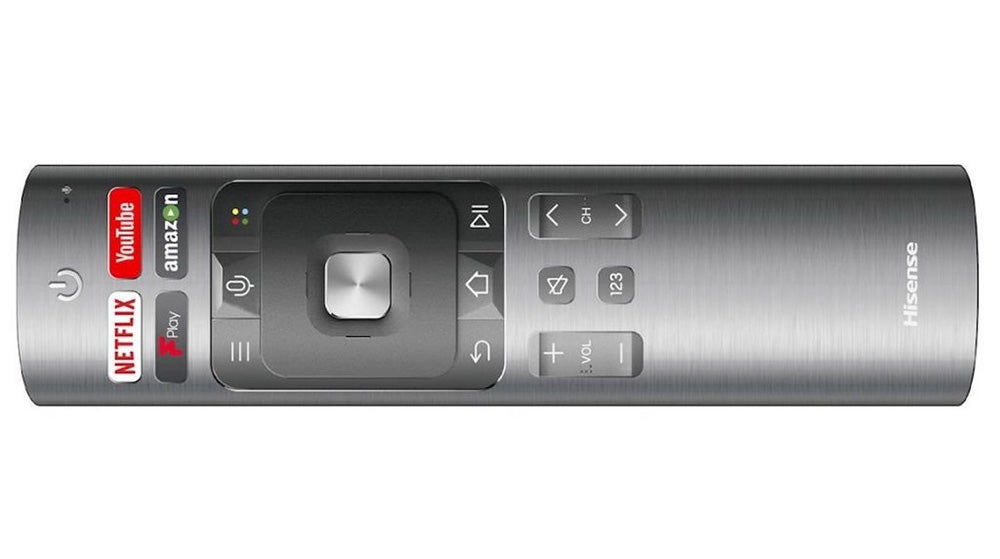
The Hisense H100LDA’s remote benefits from a spacious layout and useful buttons.
In fact, the combination of the 3000 lumens output of the projector and the screen’s uncanny ability to bounce back the light from the projector while simultaneously suppressing ambient light interference leads to images that look brighter than most, if not all, big-screen LCD TVs.
The image almost seems to glow against its surroundings, no matter how bright your room. This is pretty incredible stuff that instantly endorses the ambition and effort Hisense has apparently invested in what is, ultimately, a relatively niche product.
The fact that the Hisense H100LDA’s colours – especially reds and blues – look exceptionally vibrant with HDR sources despite the extreme brightness is a testament to how wide a colour gamut the projector can muster. But that’s not all. It’s also a result of the set doing better black levels than I’d expected to be possible from such a product.
This is partly because of the Fresnel ridging suppressing ambient light reflections, and partly because the laser/DLP engine impressively doesn’t throw all of its eggs into the brightness basket with no care for contrast.
To be clear, you can get deeper black levels from projectors made for dark rooms firing onto lower-gain screens. I’m just saying that the greyness of dark scenes on the Hisense H100LDA is much less severe than expected. Plus, it seems perfectly fair enough for a product that’s designed to replace a living room TV rather than be installed in a dedicated, blacked-out home cinema room.
When you look at it like this, its £10,999 price point starts to look pretty reasonable. After all, Sony’s VPL-VZ1000ES ultra short-throw SXRD laser projector costs £14,999 (after initially costing £19,999), with no specialist screen included in that price.
Once I’d become accustomed to the Hisense H100LDA’s colour and brightness talents, it also impressed with its sharpness and detail. With the crispest, most detailed 4K Blu-rays, I never doubted for a moment that I was watching a 4K image. In fact, the high brightness and surprisingly solid contrast, together with the sheer scale of the screen, highlights the system’s native Ultra HD resolution.
The laser projector/reflective screen combo also does a better job of selling HDR’s extra brightness (both average and peak) versus SDR than any normal projection system.
The H100LDA’s sharpness, meanwhile, shows how well it combats the geometry and focus issues often seen with ultra short-throw projector systems. There’s no hint of bowing along the image’s top or sides, and aside from a fractionally softer look to the extreme top-left edge, the image looks uniformly clear.
Nor does the screen component suffer with any hot-spotting, whereby some parts of the image – typically, the centre – on high-gain screens can “collect” light, so they look much brighter than the rest.
Moreover, from a typical seating position the screen avoids the shimmering, glimmering effect over the very image areas that again can pose a problem for other “ambient light” projector screens I’ve seen.
So far, so good. But perhaps inevitably with such an ambitious and bold new product, there are a few glitches in the matrix.
The worst of these is the way the picture reflects onto your ceiling and side walls. These reflections are bright and colourful enough to class as a significant distraction. They also create ambient light around the screen, even if you’ve decided you want to watch it in a dark room.
If you have a really colossal living room, with high ceilings and distant side walls, then maybe the reflected light might not be an issue. It’s also worth noting that the HDR Dynamic mode reduces the impact of the reflections versus the bolder HDR Day and Night modes.
For most people, though, the strikingly bright reflections on to walls are going to be something that have to be tolerated at all times. Unless you try to screen it off somehow with some light-absorbent material, that is – or maybe you kid yourself that it’s some sort of downmarket version of Philips’ Ambilight technology!
Another issue with the projector’s pictures is the rainbow effect. Namely, the appearance during very contrasty pictures (or if you flick your eyes around dark scenes) of distinct red, green and blue striping over the image’s stand-out bright areas.
This is quite common with single-chip DLP projectors, but is likely being exaggerated here by the brightness of the laser feeding through the DLP engine. Some people are more prone to seeing rainbowing than others, but you’ll have to be essentially immune to it not to see it on occasion, at least, while watching the Hisense H100LDA.
The way the Hisense H100LDA’s screen works means it’s also affected by a limited viewing angle. From as little as 20 degrees or so off-axis, the picture stars to lose some of its all-important brightness.
There’s also a touch of colour inconsistency. This is only detectable in super-bright shots, such as those near the start of Blade Runner, where K arrives at Sapper Morton’s place surrounded by white clouds and mist. Here the image looks slightly green at the edges, and reddish in the centre. The sort of content that reveals this issue is rare, though.
Next, colours can look a little heavy during dark scenes when using the Dynamic picture preset – even though colours in bright scenes look their best in this preset.
The noise reduction systems cause both softness and lag, and so should be avoided where possible. All the motion processing settings, bar Film and Off, can cause some slight flickering and glitching with fast-moving objects.
As noted earlier, the picture “clips” noticeably with bright HDR content in the HDR Day and Night modes. This becomes excessive with particularly aggressive HDR masters, such as the 4K Blu-ray of Pan.
It seems a real shame to me that Hisense hasn’t made the HDR Day and HDR Night presets more different in this respect, since there’s clearly “space” for a more effective mid-point between the HDR Day and Dynamic modes. Maybe this is something Hisense could tweak via a firmware update?
The Hisense H100LDA’s ability to upscale HD, and especially SD, to the projector’s 4K resolution is only fair to middling. Close-ups look okay, but backgrounds and relatively compressed images tend to look more soft HD than 4K.
Finally, on the picture front, most of the Hisense H100LDA’s presets tend to leave SDR images looking a little washed out – a result, I’d guess, of the projector’s brightness stretching SDR’s limited colour range too far. Although, fortunately, the Cinema Day and Dynamic SDR options save the day for dark and bright-room conditions respectively.
The Hisense H100LDA’s audio is almost as eye-catching as its pictures, insomuch as sound can ever be eye-catching, that is.
The projector’s large bodywork and use of a liquid-cooling system joins with the way you can position it right next to your wall (a long way from your seating position) to help the system run fairly quietly, despite how much heat it’s having to dissipate.
We’re not talking silence here, of the type you’d expect from the vast majority of TVs. There’s a definite but gentle whirr together with an underlying slight buzz. This sound is consistent enough to help you tune it out, though, and is certainly less obtrusive than it would be if the projector was right next to you.
The fact that the projector sits just a few centimetres from the screen also means that the audio from its built-in speakers sounds like it’s coming from at least the vicinity of the screen. There’s nothing like as much picture/sound dislocation as you experience with typical, more distant projector/screen setups.
It helps that the placement of the Hisense H100LDA’s speakers results in the sound presenting forward. Even more importantly (and uniquely for a projector based system), the subwoofer rounds out an otherwise slightly compressed mid-range with reasonably well-blended and deep bass.
The sound system presents quite a wide soundstage that distributes effects well beyond the projector’s physical dimensions. This gives it a sense of audio scale that’s at least in the same ballpark as the epic scale of the 100in visuals.
There’s a slightly buzzy distortion with deep male vocals that can also kick in with parts of loud action scenes. Some vocals sound as if they’re coming from slightly below the picture, too. Ultimately, though, you’re getting a far better sound from a projector than you normally get from even the most high-end of TVs – and that’s pretty remarkable.
Should you buy a Hisense H100LDA?
The Hisense H100LDA is such a unique proposition that we’re not really talking in this section about whether it’s better than its rivals. The closest competition is Sony’s VPL-VZ1000ES short-throw 4K laser projector – a projector with superior video processing that uses SXRD technology to avoid the H100LDA’s rainbow effect issues. But this is also a projector that doesn’t come with a TV-like ultra-bright screen, and costs four grand more.
The real question to ask about the Hisense H100LDA is whether it achieves the unique goal it sets itself: giving you a cinema-sized TV screen that can work in a normal living room without the enormous expense associated with such a large regular TV screen.
For the most part, it does better than I’d have thought possible. The brightness and colour its pictures retain, even in normal daytime living room conditions, is genuinely remarkable. It’s just a pity there’s a price to pay for this brightness in the shape of distracting wall reflections in all but the most massive rooms.
This, together with the screen’s extreme amounts of brightness, means that the H100LDA isn’t really a great candidate for a dedicated home cinema projection installation in a perpetually dark room.
But that’s exactly the point. The Hisense H100LDA doesn’t really want you to even think of it as a projector. Rather, it’s just a mammoth screen for your living room that doesn’t cost as much as normal mammoth screens. And in that respect, while it isn’t without its flaws and feels a little bit crazy, it’s mostly crazy in a good way.
How we test televisions
We test every TV we review thoroughly over an extended period of time. We use industry standard tests to compare features properly. We’ll always tell you what we find. We never, ever, accept money to review a product.
Trusted Score
Features
| Size (Inch) | 100 |
| Max. Resolution | 3840 x 2160 |
| Full HD 1080p | Yes (actually 4K) |
| Digital Tuner | Yes |
| Freeview HD | Yes |
Connectivity
| HDMI | 4 |
| Ethernet | Yes |
| WiFi | Yes (built in) |
Physical Specifications
| Height (Millimeter) | 415.8 |
| Width (Millimeter) | 689.3 |
| Depth (Millimeter) | 206.2 |
| Weight (Gram) | 22700 |

